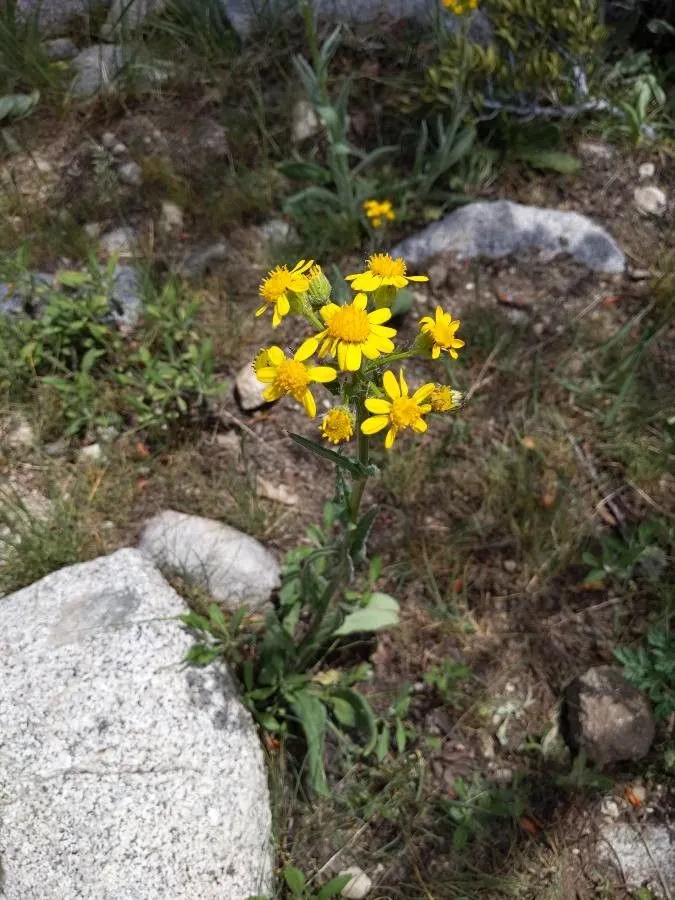
Author: Nutt.
Bibliography: Gen. N. Amer. Pl. 2: 165 (1818)
Year: 1818
Status: accepted
Rank: species
Genus: Senecio
Vegetable: Unknown
Observations: WC. & C. Canada to WC. U.S.A.
The Gaugeplant, scientifically known as Senecio integerrimus, belongs to the family Asteraceae. This resilient plant, notable for its widespread presence, can be found across a broad range of locations. Its natural habitat spans from Western and Central Canada down through to the Western United States.
Described by the botanist Nuttall in 1818 in “The Genera of North American Plants,” the Gaugeplant is integral to the ecosystems it inhabits. It typically thrives in diverse environments including open fields, meadows, and forest edges, where it contributes to the local biodiversity.
The Gaugeplant is distinguishable by its vibrant, daisy-like flowers that add a splash of color to the landscape during its bloom period. This perennial plant features finely divided leaves and a robust growth pattern that makes it a striking presence in its natural settings.
Not only is Senecio integerrimus aesthetically pleasing, but it also plays an essential role in supporting various pollinators including bees, butterflies, and other insects. The Gaugeplant’s adaptation to a wide range of climatic conditions and soil types highlights its evolutionary success and environmental value.
In conclusion, the Gaugeplant (Senecio integerrimus) is a member of the Asteraceae family that significantly contributes to the ecological fabric of North America. Its wide distribution from Canada to the USA and its role in sustaining pollinators underscores its importance in the regions’ ecological dynamics.
Eng: gaugeplant, lambstongue ragwort, single-stem butterweed, western ragwort, entire-leaved groundsel, entire-leaved ragwort, lamb’s-tongue ragwort, western groundsel
Fra: séneçon de l’ouest
En: Gaugeplant, Single-stem butterweed, Lambstongue ragwort, Lamb-Tongue Ragwort, LAMBSTONGUE GROUNDSEL, Western ragwort, Entire-leaved groundsel, Entire-leaved ragwort, Lamb’s-tongue ragwort, Western groundsel
Fr: Séneçon de l’Ouest
Taken Jun 22, 2021 by Joseph Littlehorn (cc-by-sa)
Taken May 3, 2020 by jasmine oakley (cc-by-sa)
Taken Jul 2, 2019 by M V (cc-by-sa)
Taken Jun 5, 2021 by Clint Grierson (cc-by-sa)
Taken May 16, 2020 by Kyler Bowers (cc-by-sa)
Taken Sep 21, 2015 by EOL − Barry Breckling (cc-by-nc-sa)
Taken Apr 9, 2012 by EOL − Gary A. Monroe (cc-by-nc)
Taken Feb 22, 2008 by EOL − Keir Morse (cc-by-nc-sa)
Taken May 1, 2020 by Joe Beal (cc-by-sa)
© copyright of the Board of Trustees of the Royal Botanic Gardens, Kew.
Taken Feb 22, 2008 by EOL − Keir Morse (cc-by-nc-sa)
Taken Feb 6, 2015 by EOL − Marek (cc-by-nc)
Taken Feb 6, 2015 by EOL − Marek (cc-by-nc)
Taken Jun 11, 2015 by EOL − paloma (cc-by-nc)
Taken May 1, 2015 by EOL − faerthen (cc-by-nc)
Taken Feb 22, 2008 by EOL − Keir Morse (cc-by-nc-sa)
Taken Feb 22, 2008 by EOL − Keir Morse (cc-by-nc-sa)
Family: Myrtaceae Author: (F.Muell.) K.D.Hill & L.A.S.Johnson Bibliography: Telopea 6: 402 (1995) Year: 1995 Status:…
Family: Rubiaceae Author: Pierre ex A.Froehner Bibliography: Notizbl. Bot. Gart. Berlin-Dahlem 1: 237 (1897) Year:…
Family: Sapindaceae Author: Koidz. Bibliography: J. Coll. Sci. Imp. Univ. Tokyo 32(1): 38 (1911) Year:…
Family: Asteraceae Author: A.Gray Bibliography: Pacif. Railr. Rep.: 107 (1857) Year: 1857 Status: accepted Rank:…
Family: Fabaceae Author: Medik. Bibliography: Vorles. Churpfälz. Phys.-Ökon. Ges. 2: 398 (1787) Year: 1787 Status:…
Family: Aspleniaceae Author: (Cav.) Alston Bibliography: Bull. Misc. Inform. Kew 1932: 309 (1932) Year: 1932…